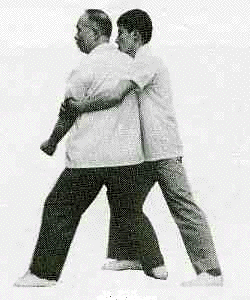
Chen Style Taijiquan (Tai Chi Chuan)
Part 1: Chen Wangting and the Early Development of Chen style
Animated Image on Left: Gu Liu Xin Applies a Self Defense Application of "Besiege the Waist, Press Elbow" from the Second Series (or Canon Fist) of Chen Style Taijiquan. The late Gu Liu Xin was a Deputy Director and researcher for the Shanghai Institute of Physical Culture. Gu Liu Xin also authored one of the first and most successful books on Chen Style that featured line drawings of Chen Fake and Chen Zhaokwei. This particular application is featured in his comprehensive book on Chen Style's Canon Fist. He was a widely recognized student of many famous Taijiquan Teachers including Chen Fake and Yang Chengfu.
Taijiquan (T'ai Chi Ch'uan) is a branch of the traditional internal martial arts (or Nei Jia Kung Fu) that spread widely in China over 300 years ago at the beginning of the Qing Dynasty. It became very popular beginning around 1911 in Beijing. Stories abound about how this martial art we now call Taichichuan may have developed around the eighth century.
by Gerald A. Sharp
Other Tai Chi Chuan pages can be found on this website. Additional resources are for sale at the chiflow.com store site.
According to research of historical records conducted by Gu Liu Xin, during the mid 1500's Qi Jiguang developed a set known as 32 forms of boxing. Today sets of 80, 108 or more forms typically refer to the number of individual postures. The numbering of 32 forms in Qi's set probably had a different meaning from the one we use today. Often these older sets had one name for an entire section or set. Like the Chen set, Qi Jiguang's set started with Lazily Belting the Clothes and Single Whip. Qi Jiguang supposedly took the forms and knowledge of 16 different martial arts schools to develop this Mother form.
From Qi Jiguang's canon, Chen Wangting (1600-1680 aka Chen Zhouting) is said to have developed his seven routines of shadow boxing. Chen Wangting was a soldier at the end of the Ming dynasty and a scholar at the beginning of the Qing dynasty. Borrowing 29 of the 32 forms of Qi Jiguang, Chen penned his treatise on his style in a work called, Song of the Canon Boxing. A comparison of this work to Qi Jiguang's, "The Canons of Boxing" shows many similarities. Without Chen's insightful commentary on the earlier work, the two documents would be virtually identical.
Chen Wangting, Ninth Generation member of the Chen Family, served as a professional soldier for the Ming Dynasty fighting rebel forces. He was exposed to a variety of battlefield martial arts, which were more important militarily before the gun appeared on the battlefield. Despite his background and perseverance, in 1644, Chen ended up on the losing side. Rebel forces began to gain an upper hand, and soon thereafter the Ming Dynasty fell. It is then that Chen Wangting likely retreated to Chen Village and developed the comprehensive martial art and internal training system we now call Chen Style Taijiquan.
|
1. Generation Numbering in the Chen Family and the Martial Arts Lineage From Chen Wangting
Because the first reference to this martial art appears with Chen Wangting in the ninth generation of the Chen family, the famous fourteenth generation Chen style masters are sixth generation in his lineage (or five generations after Chen Wangting). This makes the numbering confusing as a eighteenth generation Chen family member would be from the tenth generation of the lineage started with Chen Wangting's introduction of the art we now call Chen style Taijiquan. That is, starting with Chen Wangting as the first generation of the Chen style Taijiquan. For example, a leading present day Chen style teacher is Feng Zhiqiang, who is a tenth generation stylist from Chen Wangting. Feng Zhiqiang is often depicted as an 18th generation stylist, but this seems hard to justify. If Chen Wangting originated the style, that would make Feng Zhiqiang a ninth generation Chen Taijiquan stylist. How could he be an eighteenth generation of the Chen Family when he is not a family member? |
2. Daoyin and Tuina in Chen style
In addition to building on the 32 forms of Qi Jiguang. Chen Wangting also borrowed ideas and techniques from Daoyin (exercises that emphasized the exertion of inner force) and Tuna (deep breathing exercises). One unique feature of the seven sets he would develop was silk reeling. This twisting character of the movements appeared to onlookers to be much more smooth and graceful
|
|
3. Chen Changxing
The use Chen Wangting's style carried these unique ideas not only into hand to hand combat but into weapons practice as well. Chen took the idea of "sticking to" from pushing hands a step beyond with his development of "sticky spears" training. At the time, this was seen as an advance in the use of weapons, as guns had not yet been introduced. |
4. Chen Youbeng and Chen Qingping
By all accounts Chen Youbeng is most famous for promoting both a large frame version and a new version (known as New Style), which emphasized the value of the smallest of movements. His top student was Chen Qingping, who became extremely famous for promoting two small frame styles. His top non-family student was Wu Yuxiang who created the Wu Yuxiang style which is also sometimes referred to the Hao style. However, at this time, an enormous shift in popularity amongst versions of the Chen Style took place, spearheaded by Chen Changxing. As mentioned previously, Chen Changxing is noted as the one who organized the multiple sets into two sets known as Yi Lu and Er Lu (or, First and Second Routines). His style is characterized as two sets of "big frame" Taijiquan. He taught the first non-family student his Taijiquan for a combined 18 years. That student, Yang Luchan (A.K.A. Yang Fu Kwei), would develop his own style of Taijiquan: Yang Style Taijiquan. Chen Changxing was known for his de-emphasis of outward power. Instead he focused on the power of softness and developing a strong center of gravity by maintaining a more upright posture. There's no question that these two principles are consistent with the Traditional Yang Style Taijiquan we see today. Chen Changxing's style has also been handed down as the Lao Jia, or Old Frame. Now, whether this "old" frame is what Chen Fake and Chen Zhaokwei taught in Beijing or whether a more elaborate version remains to be verified. However, if Yang Style did develop from Changxing's version, then it would very likely have to be a more efficient version of the style. Regardless, Changxing is also credited with internalizing Heng and Hah which was a more internal version of a Ki Ai. Changxing saw huge value in developing internal power by making the sounds within his mind and vibrating them through the body, rather than aspirating them. Changxing was an outstanding internal martial artist, and both developed and preserved the efficiency and internal tenets of the style. |
|
5. Chen Youheng
A third branch was headed up by another fourteenth generation member of the Chen family named Chen Youheng. Chen Youheng developed what many see as the first "new" frame of the style. This new version was not a watering down of Chen style by any stretch of the imagination. Instead, it was viewed as an even more martial rendering of the style adapting to the ever changing face of military hand-to-hand combat. This approach was exemplified by his offspring, Chen Jishen and Chen Zhongshen who were recognized as warriors who successfully stood up to the Taiping rebels during the reign of the Emperor Hsien Feng. Some accounts credit Chen Zhongshen specifically with adding further developments of a "Big Style" that emphasized a martial prowess, and made the style more practical and adaptable to battlefield considerations. Chen Youheng's Big Style was passed on to Chen Zhonghen, as well as Chen Jishen and Chen Boshen. Chen Jishen passed it on Chen Sen. However, Chen Zhonghen was able to pass it on to Chen Yao, as well as Chen Xiao and Chen Miao. The idea of "new" is also interpreted by some to mean that Chen Youheng discovered a new approach to applying the style. In other words, he didn't alter it necessarily, but, instead, found more direct paths to application; and emphasized methods which were less flowery and more sensical. Chen Youheng's Big Style continued to live on when Chen Yao passed it on to Chen Ziming and Chen Chunyuan. However, with the popularity of the teachings of Chen Changxing's grand student Chen Fake and Chen Zhaopei, as well as the the most popular modern Chen stylist and prodigy Chen Zhaokwei, it is believed, at the very least, this version of Chen style has become obscure, and this once prominent and central branch of the style has hardly survived. That which has endured is practiced by very few. Certainly in lieu of the developments in application, it would be interesting to see Youheng's ideas brought back to life. |
6. A Personal Perspective
Because of the variation between the many versions of the Chen style, it is not unreasonable to question the origins of the version of Chen Style that comes from Chen Village today. Furthermore, practitioners who value efficiency also question why such elaborate versions are called "old" when soldiers, old and young, from this year and yesteryear, often practice that which is more direct and streamlined. While Chen Zhaopei's version may be the style most practiced in Chen Village to this day (imparting his legacy to the four horsemen of Chen Xiaowang, Chen Zhenglei, Zhu Tiancai, and Wang Xian), it certainly is not as efficient as Chen Zhaokwei's (which some refer to as "new" especially followers of Zhaopei's version); but it is a version with integrity nonetheless. Zhaopei, though, is not credited enough for what he did as a practitioner and exponent of the style, having revived the style in his home village in the 1950s, and carrying it forward through turbulent cultural episodes in China's recent history. Given the fact that the style has gone through so many generations and variations, it is impressive that it has not changed its unique characteristics of silk cocoon reeling, twisting, and powerful movements (no matter how softly or externally they are performed). Through it all, these remain the characteristics of the style regardless of its specific origin. |
|
7. Resources
Chen style Taijiquan example martial application of "Wade Forward, Twist Step." Click here to go to the Store associated with chiflow.com. There are links to Chen style Tai Chi Chuan martial applications on the COMPARISON OF APPLICATIONS page. |
8. Tai Chi Chuan Related Links
We have pages on Yang style Taijiquan and Wu (Jian Quan) style Taijiquan. The Wu style pages also include Tuishou (Push Hands), a variety of martial applications; some links to demonstration of example applications of the 13 methods of Push Hands in Wu style, a description of the Wu two hand solo practice method, and an appreciation of Wu style teachers Ma Yueh Liang and Wu Ying Hua. There is also a page about the origins of Tai Chi Chuan.
Click the Red Arrow to go to the Overview of Tai Chi Chuan page or the Green Arrow to go to Chen Style Taijiquan, Part 2 |


 >
>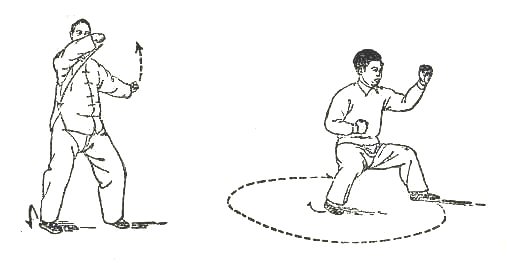
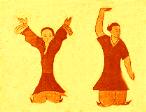
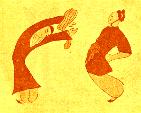 compared to other martial arts of the time. Techniques such as catching, take downs, and striking were incorporated in the training. It is said Chen Wangting also developed methods of pushing hands practice, in which the practitioners practiced twining and sticking to each other to sharpen their sense of touch. This approach to training encouraged students to hide firmness within softness.
compared to other martial arts of the time. Techniques such as catching, take downs, and striking were incorporated in the training. It is said Chen Wangting also developed methods of pushing hands practice, in which the practitioners practiced twining and sticking to each other to sharpen their sense of touch. This approach to training encouraged students to hide firmness within softness.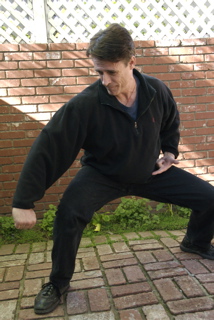 of martial arts on the battlefield were gradually de-emphasized over time after firearms were introduced. Many teachers kept interest in the martial arts going by promoting fitness, health, and longevity. Because of this, the sets of Chen Taijiquan reportedly went through great change during the next five generations after Chen Wangting. It should be noted that three prominent 14th generation Chen family members left their own pivotal signatures on the Chen style system of Taijiquan. These prominent Chen family members were Chen Changxing (1771-1853), Chen Youbeng, and Chen Youheng. Chen Changxing is forever remembered as the one who organized the sets into two sets (Yi Lu and Er Lu). Chen Youbeng developed a New Style and also maintained the Original style. This new style was supposedly a small frame style which he in turn passed on to Chen Qingping who developed Zhao Bao style Taijiquan. Chen Youheng reportedly carried on the military tradition of the art by practicing a Big Style which he passed onto Chen Jishen, Chen Zhogshen, and Chen Boshen.
of martial arts on the battlefield were gradually de-emphasized over time after firearms were introduced. Many teachers kept interest in the martial arts going by promoting fitness, health, and longevity. Because of this, the sets of Chen Taijiquan reportedly went through great change during the next five generations after Chen Wangting. It should be noted that three prominent 14th generation Chen family members left their own pivotal signatures on the Chen style system of Taijiquan. These prominent Chen family members were Chen Changxing (1771-1853), Chen Youbeng, and Chen Youheng. Chen Changxing is forever remembered as the one who organized the sets into two sets (Yi Lu and Er Lu). Chen Youbeng developed a New Style and also maintained the Original style. This new style was supposedly a small frame style which he in turn passed on to Chen Qingping who developed Zhao Bao style Taijiquan. Chen Youheng reportedly carried on the military tradition of the art by practicing a Big Style which he passed onto Chen Jishen, Chen Zhogshen, and Chen Boshen.
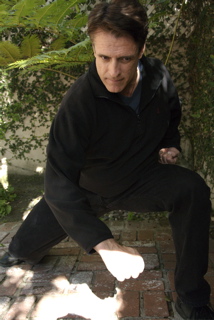 I have seen versions of "Lao Jia," or Old Frame, and versions of the "Original style," that vary widely across China and throughout the world. One such version of particular note, is taught by Mr. Huan De Hai of Shanghai. Whether it is the original frame or not, I can tell you this version of Taijiquan is very involved and all encompassing. With it's Buddhist-like palms opening to it's sets of three circles and various ellipticals (or more in some instances) per movement, there's no question of this version's completeness and integrity. This particular form's first and second series would almost equal in length three to four times what we see being imparted today from valid sources. Just watching up to the second "Buddha's Warrior Attendant Pounds Mortar" makes it is easy to accept why subsequent generations of the style would have welcomed changes that would focus on simplicity for both efficiency and learnability for future generations to be able to grasp; if in fact that which is more elaborate is "old".
I have seen versions of "Lao Jia," or Old Frame, and versions of the "Original style," that vary widely across China and throughout the world. One such version of particular note, is taught by Mr. Huan De Hai of Shanghai. Whether it is the original frame or not, I can tell you this version of Taijiquan is very involved and all encompassing. With it's Buddhist-like palms opening to it's sets of three circles and various ellipticals (or more in some instances) per movement, there's no question of this version's completeness and integrity. This particular form's first and second series would almost equal in length three to four times what we see being imparted today from valid sources. Just watching up to the second "Buddha's Warrior Attendant Pounds Mortar" makes it is easy to accept why subsequent generations of the style would have welcomed changes that would focus on simplicity for both efficiency and learnability for future generations to be able to grasp; if in fact that which is more elaborate is "old".


